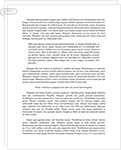 Study Document
Study Document
Heart Disease in Adult Males Term Paper
Pages:3 (972 words)
Sources:1+
Subject:Health
Topic:Heart Disease
Document Type:Term Paper
Document:#18239125
The estimated age-adjusted prevalence of angina in women age 20 and older were 3.5% for non-Hispanic white women, 4.7% for non-Hispanic black women and 2.2% for Mexican-American women. Rates for men in these three groups were 4.5, 3.1 and 2.4%, respectively. Among American adults age 20 and older, the estimated age-adjusted prevalence of coronary heart disease for non-Hispanic whites is 8.9% for men and 5.4% for women; for non-Hispanic blacks, 7.4% for men and 7.5% for women; and for Mexican-Americans, 5.6% for men and 4.3% for women. (NHANES, 1999-2002)
Coronary heart disease was the cause of death for 136.3 out of 100,000 African-Americans while killing only 95.1 per 100,000 whites in 1998. Paraphrased. (www.netwellness.com)
Influencing Social Factors
In the work entitled "Demography of Aging (1994) it is stated that:.".. Although views may differ about the desirable or appropriate extent of inequality, few would argue that inequality is irrelevant or outside the suitable domain of government action. Second, the widely available data on socioeconomic differentials in mortality and health sometimes provide important clues regarding the etiology of particular diseases, as in the case of polio, breast and cervical cancer, and coronary heart disease." (Commission on Behavioral and Social Sciences and Education, 1994)
Stated as well is: "If educational differentials in heart disease mortality were eliminated, the excess mortality of those with 0-8 years of schooling, relative to those with some college, would be reduced by 41% for males aged 25-64." (Commission on Behavioral and Social Sciences and Education, 1994)
Finally the work states "Heart disease is the principal cause of death responsible for social class differences in mortality from all causes combined. The principal approaches used to identify the courses of these differences are economic and social-psychological." (Commission on Behavioral and Social Sciences and Education, 1994)
Recommendations
Recommendations from this research are that more information is needed and should be obtained through case studies. It is critical that the lack of educational opportunities, inferior housing, healthcare opportunities as well as the plethora of other socioeconomic factors affecting the rate of heart attacks among those in crowded city areas be addressed.
References
Berkman, L. et al. (2002) Social Inequality and Health: the Impact of Social, Economic and Health Policies on Population Health - Health Effects of housing mobility policy. A report to the Russell Sage Foundation Online available at http://www.russellsage.org/publications/workingpapers/sihealth/document
Glaeser, E.L., J.L. Vigdor and T. Sanford. (2001) Racial Segregation in the 2000 Census: Promising News. The Brookings Institution, Center on Urban and Metropolitan Policy, Washington, DC.
Abramson, A.J., M.S. Tobin and M.R. VanderGoot (1995) The Changing Geography Of Metropolitan Opportunity: The Segregation Of The Poor In U.S. Metropolitan Areas, 1970-1990. Housing Policy Debate 6: 45-72.
Simmons, P.A. (2001) Changes in Minority Homeownership during the 1990s. Fannie Mae Foundation Census Notes 7: 16.
National Health and Nutrition Examination Survey (NHANES, 1999-2002), Centers for Disease Control and Prevention/National Center for Health…
Sample Source(s) Used
References
Berkman, L. et al. (2002) Social Inequality and Health: the Impact of Social, Economic and Health Policies on Population Health - Health Effects of housing mobility policy. A report to the Russell Sage Foundation Online available at http://www.russellsage.org/publications/workingpapers/sihealth/document
Glaeser, E.L., J.L. Vigdor and T. Sanford. (2001) Racial Segregation in the 2000 Census: Promising News. The Brookings Institution, Center on Urban and Metropolitan Policy, Washington, DC.
Abramson, A.J., M.S. Tobin and M.R. VanderGoot (1995) The Changing Geography Of Metropolitan Opportunity: The Segregation Of The Poor In U.S. Metropolitan Areas, 1970-1990. Housing Policy Debate 6: 45-72.
Simmons, P.A. (2001) Changes in Minority Homeownership during the 1990s. Fannie Mae Foundation Census Notes 7: 16.
Related Documents
 Study Document
Study Document
Heart Disease in Children Age
These defects or conditions are categorized according to the problems, which develop. One problem is when too much blood passes through the lungs. Another is when too little passes through the lungs. A third is when too little blood circulates in the body. And a fourth is a combination of several heart defects, presenting as a complex problem. Pediatric cardiologists are the specialists treating babies with congenital heart problems
 Study Document
Study Document
Diagnosis of Coronary Heart Disease Eric Is
Diagnosis of Coronary Heart Disease Eric is a 47-year-old who has just been diagnosed with Coronary Artery Disease (CAD). He works in the construction industry and spends most of his time away from his family i.e. wife and three children. In addition, he smokes around 1 1/2 packs of cigarettes on a daily basis and like drinking after work. Coronary Artery Disease which Eric suffers from is described as a contraction
 Study Document
Study Document
Diabetes in Middle Aged Adult Male Population
Diabetes Among Middle Age Males: One of the major public health issues among middle age males is diabetes since they are twice as likely to suffer from the disease as compared to their female counterparts. Generally, the rate of diabetes has increased in the recent past to an extent that 8% of the American population have the disease, especially children and adults. The main reason for the increase of the rate
 Study Document
Study Document
Young Adults & Heart Disease
The Archives of Internal Medicine study confirmed that 30 minutes of walking a day (10-12 miles a week) "can prevent weight gain in most people who are now inactive. Other studies have shown that working up to 10,000 steps or more could reduce the risk of heart disease, hypertension, diabetes, and obesity. Companies and organizations have encouraged their customers and members to participate in the program. ("10,000 steps a day") The
 Study Document
Study Document
Asthma or Heart Disease or Diabetes
Diabetes According to Waryasz & McDermott (2009), the global prevalence of diabetes among people aged between 20 and 79 rose to 6.4% affecting 285 million people in 2010 and the rate will rise to 7.7% affecting 439 million people by 2030. Amid 2010 and 2030, the rate of individuals with diabetes will increase by 69% in developing nations, and a twenty percent rate in developed nations. In 2011, the number rose
 Study Document
Study Document
Helping Patients with Heart Disease
Introduction
One of the goals of the Affordable Care Act (ACA) was to increase the practice of preventive medicine (Obama, 2016). As preventive care is less common in the health care industry in the U.S. than is the practice of treating patients after they have already become ill (McGlynn, Asch, Adams et al., 2003), this study aims to increase preventive care among nurses through the application of health literacy, which



